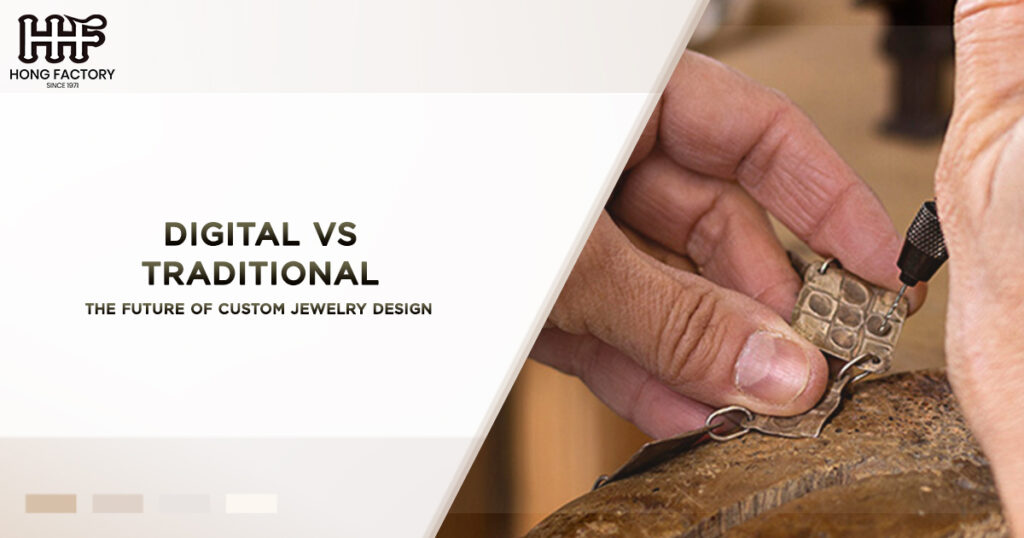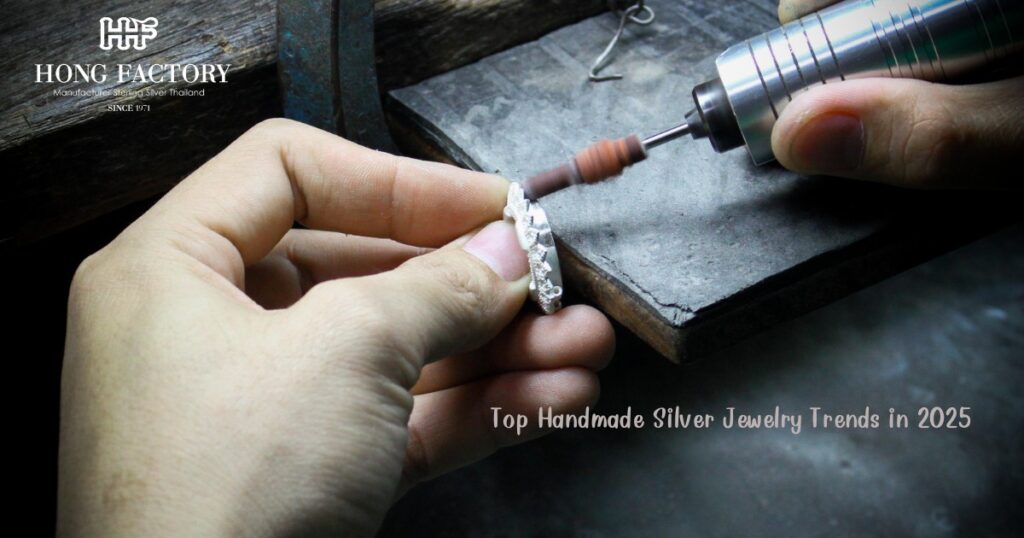
Jewelry has long been a means of personal expression, cultural representation, and artistry. With the evolution of technology, the landscape of custom jewelry design has transformed dramatically. The introduction of Computer-Aided Design (CAD) jewelry design has revolutionized how designers create and conceptualize pieces, offering a modern counterpart to traditional craftsmanship. This article compares digital and traditional design methods, exploring their unique advantages, limitations, and how they shape the future of custom jewelry design.
Understanding Traditional Jewelry Design
The Essence of Traditional Craftsmanship
Traditional jewelry design relies on skills passed down through generations, emphasizing handcrafting techniques and artisanal methods. Jewelers often start with a concept and sketch their designs on paper before selecting materials. The crafting process typically involves :
- Materials Selection : Jewelers carefully choose precious metals, gemstones, and other materials based on the design’s requirements and aesthetic goals.
- Hand Sketching : Initial sketches provide a visual concept. Traditional jewelers often have an intuitive sense of design, shaping their artworks through years of experience.
- Wax Carving : Many traditional artists utilize wax models to create prototypes of their designs. This method allows for detailed sculpting and alterations before casting in metal.
- Casting and Finishing : The final piece is crafted through methods such as lost-wax casting or hand fabrication. This stage emphasizes meticulous attention to detail and craftsmanship, often resulting in unique, one-of-a-kind pieces.
Strengths of Traditional Design
– Artistic Expression : Traditional craftsmanship allows for deep artistic expression and personalization, with each piece reflecting the jeweler’s skills and vision.
– Tactile Experience : The physical act of shaping metal and setting stones connects artisans intimately with their work, embodying a sense of pride and achievement.
– Heritage and Tradition : Many customers appreciate the historical significance of traditional techniques, valuing the stories behind each handmade piece.
Limitations of Traditional Design
– Time-Consuming : The handcrafting process can be lengthy, often taking weeks or even months from concept to completion.
– Scalability Issues : Crafting unique pieces for each customer can limit a jeweler’s ability to scale production and meet high demand.
– Potential for Human Error : While skilled, traditional craftsmanship can sometimes lead to inconsistencies in the finished product.
Embracing Modern Techniques : CAD Jewelry Design
The Rise of Digital Design
The advent of Computer-Aided Design (CAD) technology has brought about a seismic shift in the jewelry industry. CAD software allows designers to create intricate 3D models of jewelry, enabling precise measurements, detailed visualizations, and efficient modifications. This modern approach has rapidly gained traction among both new and established jewelry designers.
The CAD Design Process
- Conceptualization : Designers input their ideas into CAD software, creating a digital model of the piece. This stage allows for immediate visual feedback and adjustments.
- 3D Rendering : The software provides a realistic rendering of the design, allowing designers and clients to visualize the final product before production begins.
- Prototyping : Using 3D printing technology, jewelers can create prototypes to evaluate design feasibility and aesthetic appeal. This step is crucial for ensuring that the final piece meets the client’s expectations.
- Production : Once the design is finalized, it can be sent directly to production, often utilizing CNC (Computer Numerical Control) machines for cutting and engraving, which enhances precision.
Strengths of CAD Jewelry Design
– Precision and Accuracy : CAD technology allows for precise measurements and intricate designs, reducing the likelihood of errors and ensuring consistent results.
– Time Efficiency : The rapid prototyping capabilities of CAD significantly shorten the design process, allowing jewelers to bring pieces to market more quickly.
– Customization and Flexibility : CAD designs can be easily modified, enabling customers to make real-time adjustments to designs and ensuring a more personalized experience.
– Visualization : Digital renderings enable clients to see their designs in 3D before production, fostering greater customer satisfaction and reducing misunderstandings.
Limitations of CAD Design
– Lack of Human Touch : Some argue that CAD designs can lack the personal touch and uniqueness of handcrafted pieces, leading to a more sterile aesthetic.
– Learning Curve : Jewelers transitioning to CAD technology may face a steep learning curve, requiring time and investment to master the software.
– Reliance on Technology : Overreliance on digital processes can lead to challenges if technical issues arise, potentially delaying production.
Comparing Digital and Traditional Design Methods
To further understand the impact of digital and traditional methods in custom jewelry design, we can compare several key factors :
1. Design Process and Workflow
Traditional : The process is labor-intensive, relying heavily on manual skills. Each piece is crafted by hand, which can lead to longer production times but allows for unique artistic flourishes and imperfections that add character.
Digital : The CAD process streamlines design workflow, allowing for rapid iterations and quick adjustments. The use of 3D modeling and printing speeds up prototyping, enabling designers to create and test multiple variations quickly.
2. Customization Capabilities
Traditional : Customization often requires extensive discussions with the client and may involve multiple sketches or design revisions. The process can be slower, but the unique artisan approach allows for deeply personal designs.
Digital : CAD offers unparalleled customization, enabling clients to visualize changes immediately. Clients can experiment with different materials, stones, and design elements in real time.
3. Production Efficiency
Traditional : Due to the handcrafted nature of traditional designs, production can be significantly slower, especially for intricate pieces.
Digital : Once a digital design is finalized, production can be automated, potentially scaling to meet larger orders without loss of quality or detail.
4. Cost Considerations
Traditional : The time and skill involved in traditional craftsmanship often lead to higher prices, reflecting the value of the artisan’s labor and expertise.
Digital : While initial costs for CAD technology may be high, the efficiency of digital processes can lead to lower production costs over time, especially for businesses that can scale.
5. Appeal to Consumers
Traditional : Many customers are drawn to the charm and story of handcrafted jewelry, valuing pieces that reflect human skill and tradition.
Digital : On the other hand, tech-savvy consumers often appreciate the innovation and precision of CAD designs, favoring modern pieces that showcase intricate technology-driven aesthetics.
The Future of Custom Jewelry Design
As the jewelry industry progresses, it is clear that both traditional craftsmanship and digital techniques have their place. The future of custom jewelry design will likely involve a hybrid approach, leveraging the strengths of both methods :
- Integration of Technology in Traditional Craftsmanship
Traditional jewelers can benefit from adopting CAD technology in their workflows. This integration enables artisans to enhance their designs while maintaining the personal touch that defines handcrafted pieces. Using CAD for prototyping can help artisans perfect their creations before executing the final piece by hand.
- Emphasis on Sustainability
Both digital and traditional methods can embrace sustainable practices. CAD designs can utilize materials more efficiently, reducing waste, while traditional jewelers can focus on ethically sourced materials. Consumers increasingly prioritize sustainability, prompting the industry to adapt accordingly.
- Enhanced Customer Experiences
The future will see an increased emphasis on customer engagement and experiences. By combining the visual capabilities of CAD with the storytelling aspect of traditional jewelry, designers can create a more interactive and fulfilling purchasing journey for clients.
- Education and Training
As jewelry schools and workshops evolve, training programs will increasingly include CAD technology alongside traditional techniques, equipping new artisans with a comprehensive skill set that prepares them for a rapidly changing industry.
Conclusion
The debate between digital and traditional jewelry design methods highlights the strengths and limitations of each approach. While traditional craftsmanship embraces artistry and heritage, CAD jewelry design offers precision, efficiency, and customization. As the jewelry industry continues to evolve, the future will likely embrace a harmonious blend of both methods.
By integrating technology with the rich history of handcrafted artistry, designers can create unique, innovative pieces that resonate with modern consumers while honoring the traditions of the past. In this ever-changing landscape, both traditional and digital design will continue to shape the future of custom jewelry, offering endless possibilities for creativity, expression, and craftsmanship.


